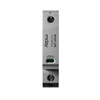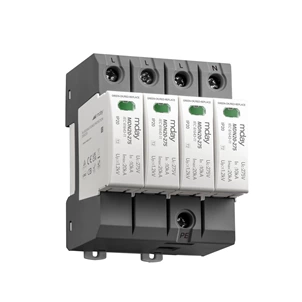Surge Protector Selection And Installation Considerations
Lightning is a repeated breakdown process of continuous discharge. The main discharge is not completed in one time. It has multiple repeated processes, generally 6-15 times, and up to more than 40 times.
Surge protector (SPD) is a lightning protection device used to discharge lightning current. It is installed in parallel on the line to protect electronic equipment by discharging surge current and limiting surge voltage.
Current problems with lightning protection
① Improper selection of lightning protection products, lightning protection failure.
② Backup protection device is disconnected by mistake, lightning protection failure.
③ Backup protection device is damaged by lightning, lightning protection failure.
④ Improper selection of backup protection device, SPD heats up and catches fire.
⑤ Failure to ensure UP/F<UW, lightning protection failure.
So how to solve these problems?
Let's first look at the relevant standards for lightning protection:
GB50057-2010 4.3.8-4/5 strong requirements: A surge protector of Class I test should be installed at the main distribution box and distribution cabinet where the low-voltage power line is introduced. The voltage protection level of the surge protector should be less than or equal to 2.5kV. The impact current value of each protection mode should be equal to or greater than 12.5kA when it cannot be determined.
GB50057-2010 J.1.2 requires: The manufacturer of the surge protector is required to install overcurrent protection devices.
GB 50343-2012 5.4.3 requires: For AC power supply lines entering buildings, at the junction of LPZ0A or LPZ0B and LPZ1 areas such as the main distribution box of the line, a surge protector of Class I test or a surge protector of Class II test should be installed as the first level of protection; at the junction of subsequent protection areas such as the distribution box of the distribution line and the distribution box of the electronic equipment room, a surge protector of Class II or Class III test can be installed as the subsequent level of protection.
GB 50343-2012 5.4.4 requires: The level of surge protector setting should comprehensively consider factors such as protection distance, length of surge protector connection wire, and rated value of impulse voltage UW of the protected equipment. Each level of surge protector should be able to withstand the expected discharge current at the installation point, and its effective protection level UP/F should be less than the UW of the corresponding category of equipment.
According to the above lightning protection standards, we should pay attention to the following points when selecting and installing surge protectors:
01 Surge protector
① The installation location must be able to withstand level I and II tests respectively to ensure continuous and effective lightning protection.
② T1-level products must meet Iimp (10/350μs) ≥ 12.5kA, Up ≤ 2.5kV. T1-level products are mainly considered to have higher tolerance.
③ T2-level products must meet the 8/20μs waveform level II test, Up≤2.5kV, In and Imax values depend on the project situation. Usually, civil projects choose Imax (8/20μs) ≥40kA.
④ For projects such as hospitals, research institutions, railways, aviation, and computer rooms, T3-level products can be installed when protecting precision instruments and equipment. They must meet the 8/20μs waveform level II test. At this time, the voltage protection level should be considered more, and products with lower Up values should be selected.
02. SPD overcurrent protection device (backup protector)
① The installation location must be able to withstand level I and II impacts without mis-breaking or damage, and ensure that lightning protection is continuously effective.
② When the SPD leakage current exceeds the standard, it can quickly cut off the power frequency current to prevent the SPD from heating and catching fire.
③ Its short-circuit breaking capacity must be large enough.
03. UP value of lightning protection branch
① The effective protection level UP/F should be less than the UW of the corresponding protected equipment (the rated value of the equipment insulation impulse withstand voltage of the protected equipment), that is, UP/F<UW, in order to ensure the effectiveness of lightning protection.
UP/F=ΔU+Up(spd)+Up(backup protector)
ΔU is the induced voltage on the connecting wire, that is, ΔU=ΔUL1+ΔUL2+ΔUL3
② According to the location of the protected equipment, select appropriate surge protectors and backup protectors.
③ Safe and effective grounding and reasonable wiring.
In summary, when selecting and installing surge protectors, we should strictly follow the requirements of the standards. We should choose high-quality surge protectors that can withstand continuous lightning current shocks. The backup protector can quickly cut off the short-circuit current and protect the SPD from fire. Pay attention to reasonable wiring during installation to ensure UP/F<UW.











